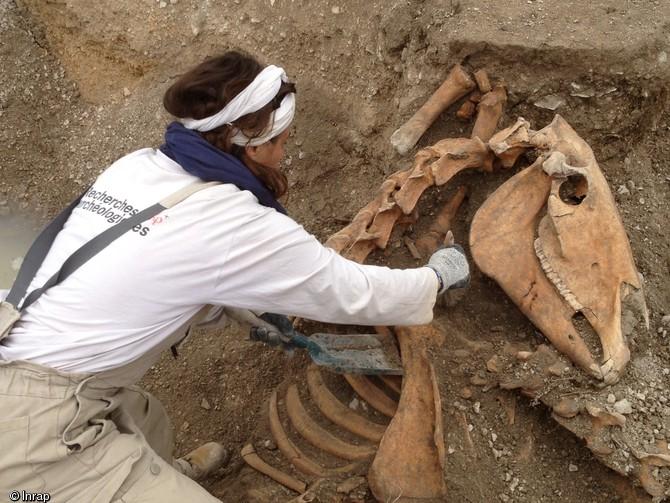You are here
Horses in the war at Bar-sur-Aube
At Bar-sur-Aube (Aube), in 2013, an Inrap team realized an archaeological excavation in advance of the construction of a new road and a housing development, under the curation of the State (Drac Champagne).
Bar-sur-Aube is the Antique Segessera, a secondary Gallo-Roman agglomeration of the city of Les Lingons. The aim of the archaeologists was to verify the presence of the road of Agrippa, the eastern branch of the Ocean road represented on the “Tabula Peutingeriana” (a map of the roads and cities of the Roman Empire dated to the 4th century AD). On this occasion, astonishing trenches filled with horse remains were discovered.
Trenches and horses

Napoleon wars or global conflicts?
Most of the forces present were composed of artillery batteries on horseback and the Kellermann cavalry division lost more than 400 men in a single assault against the Russian defenses. However, this hypothesis is not supported by the zig-zag shape of the trenches, which does not correspond to a movement war of the early 19th century. A second hypothesis is based on the presence at Bar-sur-Aube of the headquarters of the future Marshall Joffre in 1914. The city could thus have been secured by fortification lines, possibly including these military trenches installed a few hundred meters ahead of one of the mains doors to the city (the Notre-Dame door). Wounded horses arriving from the front, located a few dozen kilometers to the north, would thus have been cared for in a veterinary hospital specifically devoted to these unfortunate war companions (Blue Cross). Meanwhile, a detailed study of written documents, a study of the bones and the burial conditions of the carcasses favors a third hypothesis, which is that these are the civil defense trenches installed during the Second World War.
The presence of a site for horse requisition by the occupation troops and a German veterinary hospital (Pferdelazareth) at Bar-sur-Aube en 1940-41 have also been demonstrated. The trauma suffered by the horses did not correspond to consequences of a bombing, or to those of an intentional extermination, but probably to those of a fire. No inhabitant present during this period has any memory of this incident, but, in the last days of the German occupation the civil population of Bar-sur-Aube had to deal with many other upheavals.
The Agrippa road
The excavation of the site of Les Varennes thus dispelled an archaeological controversy concerning the Ocean road in the Aube region and adds a new page to the modern history of Bar-sur-Aube. It also shows the difficulty of interpreting some remains and the events underlying them through archaeology alone. At the site of les Varennes at Bar-sur-Aube, horseshoes lost on the Medieval road, along with those still attached to horses that died while defending France, once again illustrate the specific relationship that has linked humans and horses since their domestication.
Mahaut Tyrrell
Media communication
Inrap, media partnership and relations
01 40 08 80 24
mahaut.tyrrell [at] inrap.fr

